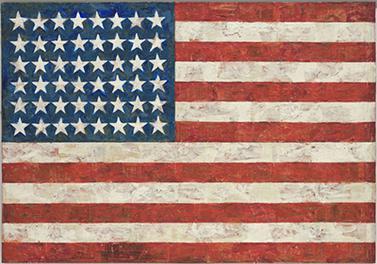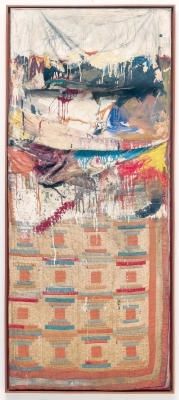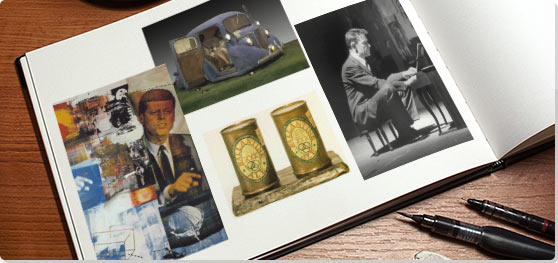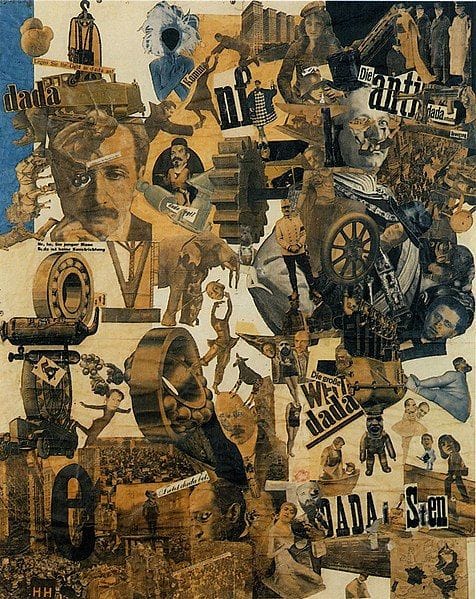Summary of Neo-Dada
The term Neo-Dada was applied to the works of artists such as Jasper Johns, Robert Rauschenberg, and Allan Kaprow who initiated a radical shift in the focus of modern art during the 1950s. Neo-Dada artists are known for their usage of mass media and found objects, as well as a penchant for performance. These artists rebelled against the emotionally charged paintings of the Abstract Expressionists that dominated the art world in the 1950s. By introducing mundane subject and emphasizing performance, the Neo-Dada artists ushered in the radical changes modern art underwent during the 1960s and paved the way for Pop art, Minimalism, and Conceptualism.
Key Ideas & Accomplishments
- Unlike the militant declarations of Dada artists, Neo-Dada artists provoked through covert strategies more suitable to the cold war climate. Neo-Dada simultaneously mocked and celebrated consumer culture, united opposing conventions of abstraction and realism, and disregarded boundaries between media through experimentation with assemblage, performance, and other hybrid fusions.
- Neo-Dada artists often encouraged viewers to look beyond traditional aesthetic standards and interpret meaning through a process of critical thinking generated by contradictions, absurd juxtapositions, coded narratives, and other mixed signals, rather than the internal emotions the action painters referenced in their abstract works.
- Neo-Dada artists adhered to Marcel Duchamp's premise that works of art are intermediaries in a process that the artist begins and the viewer completes. In the historical context, Neo-Dada revived this long dormant theoretical framework and provided the foundation for many of the contemporary art movements that followed.
- Encouraging the shift toward the viewer as part of the artwork, many Neo-Dada artists adhered to a notion that the viewer's interpretation of a work - not the artist's intent - determined its meaning. This was emphasized through the use of chance, found objects, and mass media, which helped eliminate the artist's predetermined significance and instead placed the focus on the viewer's reading of the piece.
Artworks and Artists of Neo-Dada
Theater Piece No. 1
Cage's Theater Piece No. 1, also known as simply "The Event," was a seminal performance for the evolution of Neo-Dada, paving the way for the movement's signature collaborations and multimedia basis. Conceived by Cage, the piece involved several simultaneous, unscripted performance components including a poetry reading, music, dance, photographic slide projections, film, and four panels of Robert Rauschenberg's White Paintings (1951) suspended from the ceiling in the shape of a cross. While Cage set certain guidelines for which medium each performer used, he let each individual artist determine the specifics of their role within the performance, emphasizing the function of chance in determining the course of the event. The aspects were all integral to the development of the Neo-Dada aesthetic as well as later performance art, and were encapsulated within this one work in which many of the key artists within the Neo-Dada movement played integral roles.
Multimedia performance event - Performed at Black Mountain College

Flag
Johns' use of newspaper and other media dipped in encaustic made each mark distinct and visually linked his work with the Abstract Expressionists, despite the very different processes that were involved. Rather than creating an abstract work like the action painters before him, Johns relied upon the images and signs common to American culture. He shifted the focus from the artist's mark to the interplay of emblems, language, and the media through his use of found objects embedded within the hardened wax "brushstrokes" that constitute the larger image of the American flag.
Furthermore, Johns emphasized his interest in semiotics through his use of this familiar symbol and relied upon the viewer's familiarity with the flag to imbue the work with meaning. Johns, who has referred to his paintings as "facts," does not provide an interpretation or critique of the media, language, or signs he paints - he instead relies upon the viewers to derive their own analyses. Through his revolutionary use of mass media and his focus on familiar signs, Johns moved the course of modern art away from formalist abstraction and towards Pop's attention to mass-produced objects, Conceptual art's focus on language, and, ultimately, to postmodernism's deconstruction of language.
Encaustic, oil, and collage on fabric mounted on plywood, three panels - The Museum of Modern Art, New York
Suite for Five
In Suite for Five, Cunningham emphasized the movements of dancers in groups, specifically a duet, a trio, and a quintet. The program for the original performance introduced the work by stating, "The events and sounds of this ballet revolve around a quiet center, which though silent and unmoving, is the source from which they happen." The evolving contrasts between sound and silence, movement and stillness created a dynamic tension that guided the course of the performance. John Cage's Music for Piano was the score for the piece, and relied upon the composer's use of a prepared piano with felt, screws, and woodblocks fitted in and around the strings. Robert Rauschenberg created the costume designs, which consisted of earth-toned leotards. Both Cunningham and Cage relied heavily upon chance in the creation of this work, citing that both the score and the choreography were determined by random operations like counting the imperfections in a piece of paper. Cunningham's emphasis on choreography as an art form in its own right was highlighted through his development of the dance elements outside of the score, costumes, and stage set. This focus also underscored the importance of the individual movement of the artist/dancer, which initiated the evolution of performance art that directed the viewer's attention to the body of the performer rather than the narative or the theatricality of the dance.
Dance and music performance - First performed at Notre Dame University, Muncie, IN

Bed
In this particular work, Rauschenberg took a worn pillow, sheet, and quilt, scribbled on them with pencil, applied layer upon layer of oil paint, toothpaste, and fingernail polish, quoting Jackson Pollock's drip technique in the application of each, and finally framed all of these elements within wood supports. Although this work is neither specifically a "readymade" nor necessarily an action painting, Rauschenberg references both Dada and Abstract Expressionism in his usage of found objects as well as the application of the paint to those objects. Rauschenberg effectively broke down the separations between painting and sculpture, and asked the viewer to look at modern art in a wholly new way. Through his revolutionary combination of disparate elements into a new medium that drew its subject from the surrounding world, Rauschenberg helped solidify the Neo-Dada aesthetic.
Oil and pencil on pillow, quilt, and sheet on wood supports - The Museum of Modern Art, New York
The State Hospital
With the whole sculptural environment encapsulated within a shipping crate, Kienholz created a self-contained tableau that incorporated diverse materials such as fish tanks, plaster casts, fiberglass, hospital beds, bindings, a bedpan, and neon tubing for this particular installation. With these found materials, Kienholz presents the viewer with two emaciated figures bound to their beds, sharply recreating a scene he witnessed as an orderly in a psychiatric ward. Unlike the New York Neo-Dada artists, Kienholz did imbue his works with a pre-determined meaning, which always related to his critiques of contemporary society and culture. However, through his use of found materials and his emphasis on the viewer's experience of, and dialogue with, the artwork, his connection to the Neo-Dada aesthetic and its emphasis on the surrounding world is clear.
Diverse material, environmental tableau - Moderna Museet, Stockholm, Sweden
18 Happenings in Six Parts
In this piece, Kaprow divided the gallery into three connected spaces. Over the course of ninety minutes, Kaprow and the other performers enacted simple movements like bending over, bouncing a ball, and playing records while lights and slides flicked on and off in pre-determined sequences. The audience was instructed to move from room to room at intervals throughout the work - no longer separated from the performers - they experienced the same sights and sounds as those performing. The first official happening performed within a gallery, 18 Happenings bears the diverse set of influences typical of Neo-Dada. Through the emphasis on the artist's movement as a performance, the happenings referenced the action painting of artists like Jackson Pollock, but, in this case, the movement itself became the work of art. And by allowing the happening to occur in a largely unscripted manner, Kaprow embraced Cage's notion of allowing chance to dictate the composition of an artwork.
Happening - Performed at the Reuben Gallery, New York
Beginnings of Neo-Dada
The Neo-Dada movement was initiated by the composer John Cage, artist Robert Rauschenberg, and the dancer and choreographer Merce Cunningham at Black Mountain College in North Carolina in 1952. At the school, Cage lectured about embracing aleatory processes - the role of chance - and Eastern philosophies like Zen Buddhism in the creation of art and in daily life. A student in Cage's classes, Rauschenberg began working in less-traditional artistic processes, like using an automobile tire to create a print or painting a canvas pure white so that it would reflect its surroundings as the main subject matter. In the same context, Cunningham focused on synthesizing aspects of modern dance and classical ballet with his own natural ability and "animalistic" grace, aligning dance with performance art. While many individual works and moments contributed to the definition of the Neo-Dada aesthetic, Cage's "The Event," or Theatre Piece No. 1 (1952), performed at Black Mountain College, summarized the movement's interests in the emphasis on chance, individuality, interaction with the audience, and multiple media all combined into a singular work. After moving to New York City, Rauschenberg and Johns were neighbors and often discussed their ideas about artistic practice in their studios, further refining the aesthetic, particularly the idea that the artist's intent should not be legible or present in the final work.
The label Neo-Dada was first used in 1957 by art critic Robert Rosenblum and then the following year by Thomas B. Hess, director of ARTnews magazine. The critic and art historian defined Neo-Dada as a broader movement in 1962, by which time the East Coast branch of the movement was largely considered to be over and Pop art began to captivate New York.
The Dada Tradition
Neo-Dada as a movement shares a great number of similarities with the earlier Dada movement in Europe, but as the "neo" implies, the artists reinterpreted the goals of the original movement in the context of mid-20th-century America. The original Dada artists - in Berlin, Zurich, Cologne, and Paris - mounted an assault on bourgeois culture in response to the horrific destruction of an entire generation of men during World War I. They were unified less by a specific style than by their adoption of particular strategies in which art became a tactic against contemporary culture. The Neo-Dada artists adopted similar strategies in their art, namely collage, performance, and the incorporation of chance. However, the artists of the Neo-Dada movement viewed their varied methods and mediums as a way to expand the boundaries of fine art, while the original Dadaists sought to deconstruct modern society and culture through their art.
Around this time, Marcel Duchamp lived in New York, and his art and his ideas were highly respected. Commenting on the anti-art nature of his work Duchamp wrote in a letter to the artist Hans Richter in 1962: "When I discovered ready-mades I thought to discourage aesthetics. In Neo-Dada they have taken my ready-mades and found aesthetic beauty in them. I threw the bottle-rack and the urinal into their faces as a challenge and now they admire them for their aesthetic beauty." This statement is a reminder that sometimes art sets out with certain goals, which are, with the passage of time, often redefined.
Beyond The Shadow of Abstract Expressionism
In the early 1950s, Abstract Expressionism held the mantle of the American avant-garde, and the collective of artists associated with it, including Jackson Pollock, Willem de Kooning, Franz Kline, Mark Rothko, and others, continued to capture the art world's fascination with their exercises in abstraction and their often testosterone-fueled lifestyles of drinking and womanizing. By the time the artists that came to be associated with Neo-Dada began working, Abstract Expressionism had been the primary American modern style of painting for over a decade. In 1949, the Abstract Expressionist movement was so ubiquitous within American culture that Pollock graced the pages of Life magazine. By the 1950s, second and third generations of Abstract Expressionists created works in a style that successfully penetrated all aspects of art education and production in America. When Rauschenberg erased the lines drawn by an Abstract Expressionist master in Erased de Kooning Drawing (1953), he symbolized the desire of all Neo-Dada artists to obliterate the psychological trappings embedded in the formalist aesthetics of the preceding style.
Neo-Dada: Concepts, Styles, and Trends
Robert Rauschenberg, Jasper Johns, John Cage, Merce Cunningham, and Allan Kaprow were all crucial to the Neo-Dada aesthetic. All of these artists lived and worked in New York City, exhibiting and performing in the same galleries and alternative venues, yet each developed an individual style that drew on the objects and acts of everyday life to create art. In addition to the New York City artists, there also were many artists, like Edward Kienholz, that worked in California in what came to be known as a "Funk" art style, which also utilized found objects as art, often in order to critique society.
Robert Rauschenberg and Combines
Soon after the Erased de Kooning Drawing (1953), Rauschenberg created a new form of assemblage that bridged multiple mediums. The "Combine" or "combine painting" was conceived by Rauschenberg in 1954 and incorporated found objects, paint, print, and sculpture into a multimedia object that transcended traditional divisions between mediums. While some Dada and Surrealist predecessors such as Marcel Duchamp, Kurt Schwitters, and Joseph Cornell had experimented with assemblage in many forms, Rauschenberg's Combines incorporated cast-off pieces of ephemera within the paintings themselves, leaving viewers to question and interpret the painting's intent. The resulting effect of the Combines was a jarring juxtaposition that broke down the lines that traditionally separated mass culture from fine art. Rauschenberg ushered in a postmodern sensibility in which the focus of art shifted from the psyche of the artist to the spontaneous amalgamation of objects and art mediums into a work that dissected contemporary life.
Jasper Johns and Semiotics
In 1958, after Johns' wildly successful first solo exhibition in New York, critics seized on the way he utilized commonplace materials to create aesthetically driven images. He aimed to work with "things the mind already knows," such as targets, flags, letters and numbers, that he rendered using newsprint and magazines dipped in encaustic, a type of molten wax, to create the individual marks, or "brushstrokes," that built each image. By using newspapers and other media as the basis of the flags, targets, letters, and numbers, Johns emphasized the bombardment of symbols in contemporary mass media, heightened by the discord between the legibility of the well-known symbols and the illegibility of the embedded words and images within the encaustic. His choice of medium quoted the gestural brushwork of the Abstract Expressionists, with each movement and mark frozen in time. Through his re-presentation of familiar things, Johns abstracts the surroundings of everyday life, simultaneously criticizing Abstract Expressionism for its inattention to anything but the artist's psyche while also commenting on the inundation of the mass media within Americans' daily lives in the modern world.
John Cage and Chance
During his work as a professor at Black Mountain College, John Cage cemented certain ideals that came to define Neo-Dada, particularly the role of chance in making art, as well as the artist's control over the definition of art and its creation. In 1952, Cage released his controversial 4'33" (Four minutes, thirty-three seconds), a three-movement composition that required a sole musician be present with any instrument and sit in absolute silence for the full duration, allowing the sounds of nature and the audience members to create the music. If nothing else, this paradoxical and utterly spontaneous work of art was a direct challenge to the status quo of music, composition, and performance. In this regard, 4'33" follows in the tradition of Dadaist Marcel Duchamp, whose artistic practices were altogether satirical, ironic, self-effacing, and above all free from the formal criteria of "traditional" avant-garde art. John Cage continued throughout his career to create compositions and performances that relied on external forces and controlled chance, effectively shifting the focus of the artwork from the creator's emotional intent to the surrounding, external world.
Merce Cunningham and Dance as Performance
Merce Cunningham's work with various artists, composers, dancers, performers, and musicians throughout his career set a precedent for the development of a performative art that transcended the boundaries of dance, theater, art, and music. He founded the Merce Cunningham Dance Company at Black Mountain College in 1953, with John Cage occupying the roles of composer, conductor, and musical director. The prior year, Cage staged "The Event" (1952), or Theatre Piece No. 1, through an important collaboration with Cunningham; Cunningham's signature style of individual muscular grace was integral to the work's destruction of the boundaries between audience and performance, as he danced amidst the audience bringing them into the heart of the event. Like Cage, Cunningham avidly employed programmed chance as a determining factor in his works, allowing the structured chaos to shape his choreography. Rauschenberg was the company's first artistic director, followed by Johns, who throughout his long tenure with the company incorporated the designs of artists like Andy Warhol, Bruce Nauman, and Frank Stella into the company's productions. Through Cunningham's innovative choreographies exploring movement and duration, creative partnerships, and radical methodologies, he revolutionized modern dance as well as performance art.
Allan Kaprow and Happenings
Much like Rauschenberg, Allan Kaprow was heavily influenced by John Cage and was also a great admirer of the Abstract Expressionists. In line with the majority of the Neo-Dada artists, Kaprow sought new ways of combining art and life within his work, particularly by attempting to extend the intentions of the action painters beyond the canvas, into life. In his 1958 essay, "The Legacy of Jackson Pollock," Kaprow described his desire for a concrete art, calling for an end to permanent works of art in favor of ephemeral materials and events. This essay also outlines how these events could move the legacy of the action painters into a new form of art that emphasized the performative act and the audience's reception over the artist's intent, as was typical of the Neo-Dada movement. This call for a radical shift in modern art manifested itself in the late 1950s and early 1960s with the development of Kaprow's iconic "happenings," a mode of quasi-improvised performance art often guided by an idea that relied heavily on audience participation as well as an environment filled with seemingly random objects, smells, actions, and sounds. The happening was an immersive experience, for artists and audience alike, that was specific to a singular occasion and could not be recreated. Kaprow was not only driven by the notion of a performance of daily life, but he also aimed to refute the notion of the art object as a commodity. After the Abstract Expressionists gained immense fame and financial success from their paintings, Kaprow sought to create works that could not be bought and sold, but only experienced. Other key artists of this period who were integral to the development of happenings included Red Grooms, Jim Dine, Robert Whitman, David Tudor, and Yves Klein, among others.
Edward Kienholz and West Coast "Funk Art"
The founder of the two top avant-garde galleries in Los Angeles, Edward Kienholz was at the forefront of the Beat, or Funk, art movement in California. Although he lacked a formal art training, Kienholz had produced art since his teens, and began creating his signature installation assemblages in the early 1960s. Works like The State Hospital (1964-66) incorporate a vast amount of found objects, including hospital beds, fiberglass, and fluorescent tubing, to create an immersive environment that captures the mood or idea - in this case the cruel treatment of patients in a state psychiatric institution. In addition to Kienholz, other artists working in California, like Jay DeFeo, Wally Hendrick, and Bruce Conner, also created assemblages that broke down the lines between sculpture, painting, and mass culture. These artists often included political subtexts in their works that were largely absent from the art of their East Coast cohorts who strongly objected to any implication that the artist's intent dictated the meaning of a work of art. Kienholz co-founded the Ferus Gallery, which was an integral venue for the California artists, and exhibited work that the established New York galleries deemed too risky to show - this included Andy Warhol's Campbell's Soup Cans (1962). The newness of the art world in California allowed artists greater freedom than the highly competitive and formalism-dominated scene in New York City. This freedom was translated into artworks that made social, cultural, and political commentaries, incorporated unconventional mediums, and helped redefine what constituted fine art.
Later Developments - After Neo-Dada
Although loosely associated as a movement by art critics, the artists labeled Neo-Dada never recognized this designation and never really saw themselves as a part of a uniform avante-garde style. By 1962, when Barbara Rose officially defined the movement, all of the principal players had already achieved fame and critical admiration within the art world. As the 1960s moved forward, Neo-Dada's turn toward the external world of mass culture as material for fine art paved the way for Pop art's specific focus on consumer objects and popular images. As artists such as Andy Warhol and Roy Lichtenstein captured the public's imagination with their soup cans and comic book images, the art world's focus shifted to Pop art. However, both Rauschenberg and Johns continued to paint and create prints for several decades, always using their art to engage with their contemporary contexts. Cunningham was immensely influential in modern dance and many of his collaborators and dancers, like Viola Farber, Paul Taylor, and Carolyn Brown, went on to create their own successful performances and companies. Kaprow's happenings paved the way for the international Fluxus groups' actions and the general performance art movement in the late 1960s and 1970s, and also set a standard of interactivity, multimedia, and an art of everyday life that was a huge influence for later contemporary art. Strains of Neo-Dada persisted throughout the 1960s, and even longer in various international movements. For example, Arte Povera was a movement founded in Italy that maintained a disdain for corporate culture and conventional art, while the French Nouveau Réalisme artists favored the depiction of real objects over pure abstraction and sought to merge art and life.
Useful Resources on Neo-Dada
- Neo-Dada: Redefining Art 1958-62Our PickBy Susan Hapgood, Maurice Berger, Jill Johnston
- An Audience of Artists: Dada, Neo-Dada, and the Emergence of Abstract ExpressionismOur PickBy Catherine Craft
- Chance and Circumstance: Twenty Years with Cage and CunninghamBy Carolyn Brown
- Random Order: Robert Rauschenberg and the Neo-Avant-GardeBy Branden W. Joseph
- Happenings and Other ActsBy Mariellen Sandford
- Triumph of Anti-Art: Conceptual and Performance Art in the Formation of Post-ModernismBy Thomas McEvilley
- Silence: Lectures and WritingsOur PickBy John Cage, Kyle Gann
- A Year from Monday: New Lectures and WritingsBy John Cage
- The Dancer and the Dance: Merce Cunningham in Conversation with Jacqueline LesschaeveBy Merce Cunningham, Jacqueline Lesschaeve
- Essays on the Blurring of Art and LifeOur PickBy Allan Kaprow, Jeff Kelley
 Ask The Art Story AI
Ask The Art Story AI






















